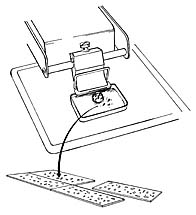- 澤任訂制
- FST動(dòng)物實(shí)驗(yàn)器械
- 瑞士ideal-tek鑷子
- 瑞士Dumont鑷子
- Weller
- Techni-Tool
- 瑞士Rubis鑷子
- arosurgica
- Genesee Scientific
- Gilder Grids
-
Entegris
- WEICON
- ACCURIS
- AIMS
- RMC鉆石刀
- Sipel鑷子
- 德國(guó)WIHA
-
Si-Mat
- Jokari
- Circuitmedic
-
Glissando病理切片掃描儀
- KNIPEX(凱尼派克)
- Swann-morton
- Cellpoint Scientific
- Swanstrom
- All-spec
-
新華器械
- Excelta
- MENDA
- MEISEI
- Erem
- Regine
-
OPTRASCAN病理掃描儀
- Benchmark
-
IDEAL
- 大龍儀器
- 五洋醫(yī)療
- Hozan(寶山)
- 3M
- Stoelting
- Roboz
-
Diatome鉆石刀
- Fine Science Tools
- PLATO
- NanoSoft
-
Avantama
-
PSI打擊器及配件
- Aptum
- xuron
- SPI
- ASI Instruments
-
上海一恒
-
上海雷磁
- Quantifoil
- 上海方需
- 蘇州六六
-
Hamilton
- ISMART
-
顯微鏡
-
Bonllmann
- AVEN
- 塔望科技
-
瑞典Haglof激光測(cè)距儀
- STILLE
-
美國(guó)安維迪
- 德國(guó)貝朗蛇牌
- Medline
-
蛋白純化系統(tǒng)
-
OHAUS奧豪斯
- 康博特森
- Ossila
-
賽寧(蘇州)生物
- Bernstein
- 潔盟清洗機(jī)
-
Ted Pella
-
晶圓切割
-
Omniprobe FIB全鎢取樣針
-
新產(chǎn)品
-
矩陣
-
器械盒
-
切割套裝
-
手套
-
樣品盒
-
吸筆及吸盤
-
晶圓及晶圓盒
-
樹脂及耗材
-
金剛石懸浮液
-
實(shí)驗(yàn)室樣品瓶及杯子
-
實(shí)驗(yàn)室防護(hù)
-
石蠟
-
移液器及管
-
離心管及支架
-
計(jì)時(shí)器
-
玻片儲(chǔ)存盒
-
焊接棒
-
微型小鏟
-
夾持器及微針
-
耳標(biāo)及耗材
-
縫合夾及縫合針
-
放大鏡
-
止血鉗
-
氮化硅膜
-
耗材
-
導(dǎo)電膠及膠帶
-
骨剪及剪刀
-
膠帶及標(biāo)簽
-
顯微載玻片
-
碳粉及碳棒
-
切片機(jī)刀片
-
切片模具
-
電鏡載網(wǎng)
-
刀類
-
化學(xué)生物制樣
-
組織標(biāo)記染料
-
鉗子
-
樣品臺(tái)
-
拋光布
-
藍(lán)寶石基片
-
吸筆
-
打孔器
-
云母片
-
AFM用品
-
鉆石劃線筆
-
樣品臺(tái)盒
-
筆
-
儀器
-
晶圓鉗
-
晶圓切割
- DSI
- Keller
-
Smart Tweezers
- 瑞士PB
-
Microscopes Internat...
- Lattice Gear
-
凱氏定氮儀
- lindstrom
- 美國(guó)EMS
-
1-material
-
儀器
- realisticflies
- Boive
- Zivic
ACLAR® Film
ACLAR® Film provides an oxygen barrier when flat embedding specimens for electron microscopy and light microscopy,
it separates easily from epoxy and is chemically inert
|
Epoxy embedments sandwiched between ACLAR® sheets
 Disc Punches are available in four sizes: 5/16" (7.9mm) 3/8" (9.5mm) 7/16 (11.1mm) 1/2" (12.7mm)
 Press between glass plates  Fresh material is cut on a vibratory slicer, treated with HRP and placed on ACLAR® cut into a slide shape - observe under LM - if OK, process for TEM on the slide. |
The 1968 paper1 by E. B. Masurovsky and R.P. Bunge was the first to describe and clearly demonstrate the useful chemical and physical properties of ACLAR® for both tissue culture and electron microscopic purposes. It was first used in the space program and its properties were found to be interesting for biomedical research (personal communication, Dr. E. Masurovsky). Subsequent work by others developed ACLAR® applications; attention is brought to that done by Mawe, et al 2, and the comprehensive ACLAR® study by Kingsley and Cole3. ACLAR® overcomes a number of problems regarding the processing of tissue culture cells, epoxy embedments, sectioning and observations because of its chemical inertness, non-stick property, glass clarity, flexibility and smooth surface. It may be cut with scissors or blades and does not damage microtomy knives. It is unsurpassed in moisture barrier protection, transparent to UV and is plasticizer and stabilizer free. It is nonflammable, nonaging and has a low dielectric constant and dissipation. It is high in dielectric strength. ACLAR® can be sterilized. Features of ACLAR® Film:
ACLAR® is offered in sheet form, 8 x 12.5" (203 x 318mm) with 7.8 mil (0.2mm) thickness.
References, ACLAR® Film 1. Masurovsky EB, Bunge RP: Fluoroplastic coverslips for long-term nerve tissue culture. Stain Technology, 43, 3, 161-165 (1968) 2. Mawe GM, Bresnahan JC, Beattie, MS: Ultrastructure of HRP-labelled neurons: a comparison of two sensitive techniques. Brain Research Bulletin, 10, 551 (1983) 3. Kingsley RE, Cole NL: Preparation of cultured mammalian cells for transmission and scanning electron microscopy using Aclar film. J of Electron Microscopy Technique, 10, 77-85 (1988)
ACLAR® Embedding Film
Physical Data
|
| Density | 2.12 |
| Thickness | 7.8 mil (0.198mm) |
| Clarity | Clear |
| Water Absorption | nil |
|
Water Vapor Transmission Rate @ 100°F (37.7°C) / 100% RH |
0.003gm / 100in2 / day (0.047gm / m2 / day) |
|
Dimensional Stability, 10 min @ 300°F (149°C) |
<2% |
|
Dimensional Change, 10 min. @ 300°F (149°C) |
< 2% |
| Thermal Conductivity | 4.7 x 10-4 cal-cm/cm2sec °C |
| Crystalline Melting Point |
395.6 - 399.2°F (202 - 204°C) |
| Flammability | Nonflammable |
Chemical Resistance Data
| Acetone | No effect |
| 100% Ethyl alcohol | No effect |
| Liquid Nitrogen | Remains flexible |
| Osmium Tetroxide | No effect |
| Propylene Oxide | No effect |
| Butyl Alcohol | None |
| Carbon Tetrachloride | Slightly flexible |
| 1,2-Dichloroethane | None |
| Ethyl Acetate | Very flexible |
| Ethyl Ether | Very flexible |
| Ethylene Oxide | Very flexible |
| Formic Acid | None |
| Gasoline | None |
| All Acids (HCl, H2SO4..) | None |
| Methanol | None |
| Toluene | Slightly flexible |
| Plastisolve |
None |



